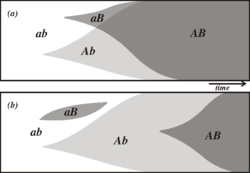Evolution of sex
|
|
The evolution of sex is a major puzzle in modern evolutionary biology, due to the so-called two-fold cost of sex. Several explanations have been suggested by biologists including Bill Hamilton, Alexei Kondrashov, and George Williams to explain how this cost of sex is overcome.
| Contents |
The two-fold cost of sex
Evolsex-dia1a.png
In all sexual species, the population consists of two sexes, only one of which is capable of bearing young (with the exception of simultaneous hermaphrodites). In an asexual species, each member of the population is capable of bearing young. Intrinsically, this implies that with each generation, an asexual population can grow more rapidly.
If this "cost", first described in mathematical terms by John Maynard Smith, were not enough alone, males and females must search for each other in order to mate, and sexual selection often favours traits that reduce the survival of individuals.
However, evidence that the cost is not insurmountable comes from George Williams, who noted the existence of heterogonic species - species which are capable of both asexual and sexual reproduction. These species time their sexual reproduction with periods of environmental uncertainty, and reproduce asexually when conditions are more favourable. The important point is that these species are observed to reproduce sexually when they could choose not to, implying that there is a selective advantage to sexual reproduction.
In order for sex to be evolutionarily advantageous, it must be associated with a significant increase in the fitness of offspring. Several explanations have been posited for this, most of which fall into two categories:
- to aid in the spread of advantageous traits
- to aid in the removal of deleterious genes
Sex aids in the spread of advantageous traits
Sex creates novel genotypes more rapidly
Sex could be a method by which novel genotypes are created. Since sex combines genes from two individuals, sexually reproducing populations can more easily combine advantageous genes than can asexual populations. If, in a sexual population, two different advantageous alleles arise at different loci on a chromosome in different members of the population, a chromosome containing the two advantageous alleles can be produced within a few generations by recombination. However, should the same two alleles arise in different members of an asexual population, the only way that one chromosome can develop the other allele is to independently gain the same mutation, which would take much longer.
Ronald Fisher also suggested that sex might facilitate the spread of advantageous genes by allowing them to escape their genetic surroundings, if they should arise on a chromosome with deleterious genes.
These explanations for the evolution of sex depend upon the rate of mutation, though. If favourable mutations are so rare that each will become fixed in the population before the next arises, then sexual and asexual populations would evolve at the same rate.
Additionally, these explanations depend upon group selection, which is a weak selective force relative to individual selection - sex is still disadvantageous to the individual due to the two-fold cost of sex. Therefore, these explanations do not explain why heterogonic species choose to adopt sexual reproduction, as George Williams pointed out in his balance argument, and hence are insufficient to explain the evolution of sex.
Supporters of these theories respond to the balance argument that the asexual and sexual propagules of heterogonic species may differ in other respects too - which may influence the persistence of sexuality. For example, in water fleas of the genus Cladocera, sexual offspring form eggs which are better able to survive the winter.
Sex increases resistance to parasites
One of the most widely accepted theories to explain the evolution of sex is that it evolved as an adaptation to assist sexual individuals in resisting parasites, also known as the Red Queen hypothesis.
When an environment changes, previously neutral or deleterious alleles can become favourable. If the environment changed sufficiently rapidly (i.e. between generations), these changes in the environment can make sex advantageous for the individual. Such rapid changes in environment are caused by the co-evolution between hosts and parasites.
Imagine, for example that there is one gene in parasites with two alleles p and P conferring two types of parasitic ability, and one gene in hosts with two alleles h and H, conferring two types of parasite resistance, such that parasites with allele p can attach themselves to hosts with the allele h, and P to H. Such a situation will lead to cyclic changes in allele frequency - as p increases in frequency, h will be disfavoured.
In reality, there will be several genes involved in the relationship between hosts and parasites. In an asexual population of hosts, offspring will only have the different parasitic resistance if a mutation arises. In a sexual population of hosts, however, offspring will have a new combination of parasitic resistance alleles.
In other words, like Lewis Carroll's Red Queen, sexual hosts are continually adapting in order to stay ahead of their parasites.
Evidence for this explanation for the evolution of sex is provided by comparison of the rate of molecular evolution of genes for kinases and immunoglobulins in the immune system with genes coding other proteins. The genes coding for immune system proteins evolve considerably faster (Kuma, Iwabe and Miyata 1995; Wolfe and Sharp 1993).
Critics of the Red Queen hypothesis question whether the constantly-changing environment of hosts and parasites is sufficiently common to explain the evolution of sex.
Sex aids in the removal of deleterious genes
Mutations can have many different effects upon an organism - and it is generally believed that the majority of non-neutral mutations are deleterious. There are two main hypotheses which explain how sex may act to remove deleterious genes from the genome.
Sex allows reconstruction of mutation-free individuals
Main article: Muller's ratchet
In a finite asexual population under the pressure of deleterious mutations, the random loss of individuals without such mutations is inevitable. This is known as Muller's ratchet. In a sexual population, however, mutation-free genotypes can be restored by recombination of genotypes containing deleterious mutations.
This mechanism will only work for a small population - in a large population, random loss of the most fit genotype becomes unlikely.
Sex acts to encourage removal of deleterious genes
This hypothesis was proposed by Alexei Kondrashov, and is sometimes known as the deterministic mutation hypothesis. It assumes that the majority of deleterious genes are only slightly deleterious, and affect the individual such that the introduction of each additional mutation has a disproportionally large effect on the fitness of the organism. This relationship between number of mutations and fitness is known as synergistic epistasis.
By way of analogy, think of a car with several minor faults. Each is not sufficient alone to prevent the car from running, but in combination, the faults combine to prevent the car from functioning.
Similarly, an organism may be able to cope with a few defects, but the presence of many mutations could overwhelm its backup mechanisms.
Kondrashov argues that the slightly deleterious nature of mutations mean that the population will tend to be composed of individuals with a small number of mutations. Sex will act to recombine these genotypes, creating individuals with fewer and more deleterious mutations, and since there is a major selective disadvantage to individuals with more mutations, these individuals die out. In essence, sex ghettoizes the deleterious mutations.
There has been much criticism of Kondrashov's theory. As well as making broad assumptions of the relationship between mutations, it requires a very high mutation rate - a rate of one mutation per generation.
Other explanations for the evolution of sex
Sex prevents rapid evolution
Ilan Eshel suggested that sex prevents rapid evolution. He suggests that recombination breaks up favourable gene combinations more often than it creates them, and sex is maintained because it ensures selection is longer-term than in asexual populations - so the population is less affected by short-term changes. This explanation is not widely accepted, as its assumptions are very restrictive.
Sex creates variation among siblings
George Williams proposed an explanation for the evolution of sex, where the advantage of sex is the creation of variation among siblings.
He gave an example based around the elm tree. In the forest of this example, empty patches between trees are considered capable of supporting one individual each. When a patch becomes available because of the death of a tree, there will be competition to fill the patch. Since the chance of a seed being successful in occupying the patch depends upon its genotype, and a parent is unable to anticipate which genotype is most successful, each parent will send many seeds, creating competition between siblings. Selection therefore favours parents which can produce a variety of offspring.
The problem with this hypothesis is that although it undoubtedly applies to some situations, it is not sufficiently general to explain the evolution of sex in a wide variety of species.
References
- Hamilton, W. D. et al. "Sexual reproduction as an adaptation to resist parasites" 1990. Proceedings of the National Academy of Sciences (PNAS) 87:3566-3573.
- Hurst, L. D. and Peck, J. R. "Recent advances in the understanding of the evolution and maintenance of sex" 1996. Trends in Ecology and Evolution 11:46-52.
- Kondrashov, A. S. "Deleterious mutations and the evolution of sexual reproduction" 1988. Nature 336:435-440.
- Maynard Smith, J. The Evolution of Sex 1978.
- Maynard Smith, J. & Szathmary, E. The Major Transitions in Evolution 1995
- Ridley, M. Evolution 1993.
- Williams, G. C. Sex and Evolution 1975.


